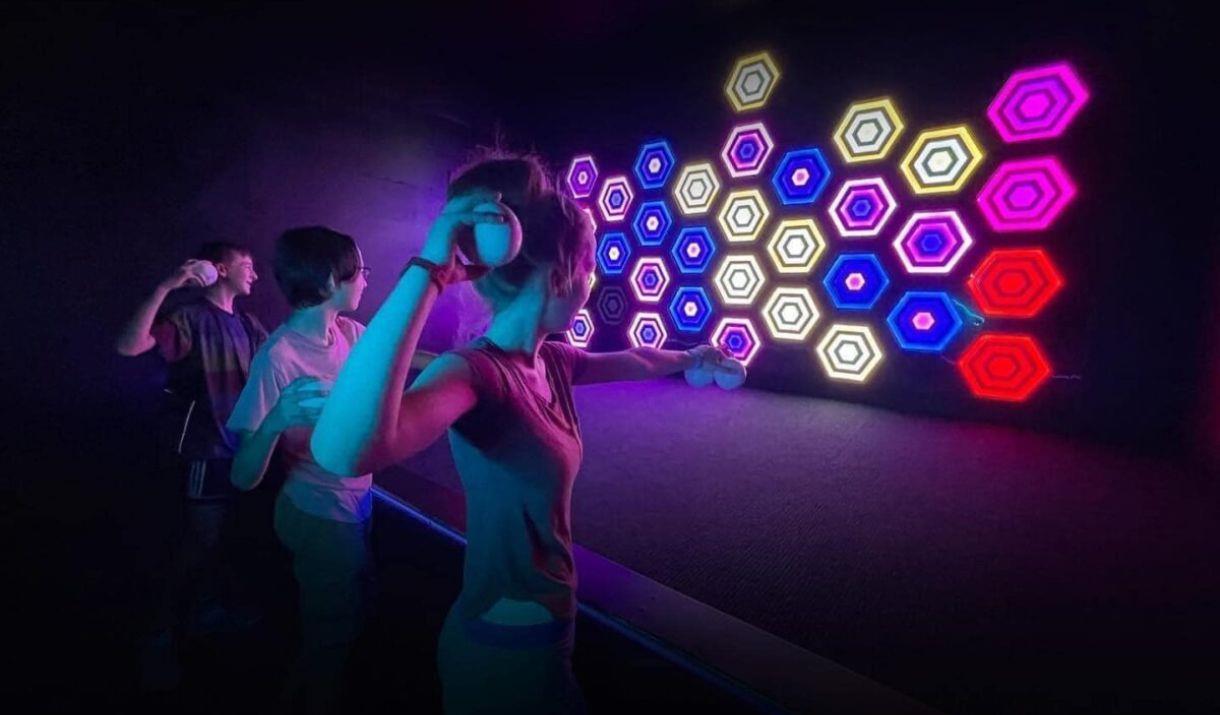Standing still is the fastest way to fail in today’s FEC market. With 68% of families seeking venues that “get kids moving while having fun,” active entertainment has shifted from optional upgrade to survival requirement. As 2026 approaches, these five trends separate thriving centers from obsolete ones. Each includes actionable implementation steps you can execute this quarter.
1. Immersive AR/VR Integration That Actually Works
Early VR installations flopped due to isolation and motion sickness. 2026’s successful active entertainment integrates augmented reality that enhances—rather than replaces—physical activity. Picture trampoline zones where AR projections create changing landing targets, or climbing walls where VR headsets show dynamic escape routes requiring real-world movement.
The breakthrough is “shared immersion.” Families experience the same digital overlay simultaneously, maintaining social connection while adding visual excitement. Hardware costs have dropped 60% since 2023, with ruggedized AR headsets designed for high-impact play now retailing under $400. Software platforms offer FEC-specific content libraries with monthly licensing fees, eliminating custom development costs.
Action step: Pilot one AR-enhanced attraction in a 200-square-foot zone. Track session duration versus traditional attractions. Most operators see immediate 25-35% increases in repeat plays. Choose systems with offline functionality to avoid WiFi dependency issues during peak hours.
2. Social Media-First Attraction Design
If it’s not shareable, it’s invisible. Modern active entertainment must generate Instagram Reels and TikTok moments organically. This means designing “hero shots”—visually spectacular moments engineered into the play experience. A zipline launch with perfect lighting, a rotating climbing wall segment that creates optical illusions, or a jump platform with branded backdrops and automatic slow-motion capture.
Smart FECs install automated camera systems with AI framing that captures peak action moments and wirelessly sends them to visitors’ phones with branded overlays. The technology costs less than $5,000 per zone but generates hundreds of organic social posts monthly. One Texas FEC’s ninja course auto-share feature produced 12,000 tagged posts in six months, equivalent to $80,000 in paid social reach.
Implementation is straightforward: identify your three most photogenic moments, install fixed cameras with motion triggers, and integrate with a white-label sharing platform. Ensure GDPR/CCPA compliance with clear consent prompts at entrance kiosks. The ROI is immediate—43% of visitors report discovering FECs through social media, and shareable moments increase group booking inquiries by 31%.
3. Subscription-Based Unlimited Play Memberships
The Netflix model conquers active entertainment. Families exhausted by per-attraction pricing embrace monthly subscriptions offering unlimited access to active play zones. The key is tiered participation: a $39/month “Active Kid” pass for weekday access, $69/month family plans, and $99/month premium tiers including guest passes and priority reservations.
This model transforms unpredictable revenue into predictable MRR (monthly recurring revenue). Top-quartile FECs now generate 55% of total income from subscriptions, reducing dependence on weather and seasonal fluctuations. The psychological shift is critical—subscribers visit 3.2 times monthly versus 1.4 times for pay-per-visit customers, dramatically increasing food, beverage, and party revenue.
Launch strategy: Start with a soft launch to your existing email list offering founding member rates. Cap initial subscriptions to create scarcity, then gradually increase caps as you optimize capacity management. Use a simple RFID wristband system for seamless check-ins. The critical success factor is managing peak capacity—reserve 30% of slots for subscribers while keeping 70% available for daily admissions and party bookings.
4. Multi-Generational Active Zones
Stop segregating by age. 2026’s winning FECs create challenges where 8-year-olds, parents, and grandparents contribute equally to family success. Think cooperative laser tag missions where different age groups have complementary abilities, or puzzle-based active courses where physical tasks require intergenerational teamwork.
Design principles include adjustable difficulty handles on every element, cognitive challenges that leverage adult skills while requiring child agility, and clear role differentiation. A “family rescue mission” attraction might have grandparents decoding patterns to unlock doors while children crawl through tunnels to retrieve objects and parents bridge gaps with balance beams.
The business impact is profound: multi-generational attractions increase average party package sizes by 40% as extended family members attend. They also drive premium pricing—venues charge 25% more for attractions marketed as “family team-building” versus standard play zones. Grandparents, often the highest discretionary spenders, become advocates when they feel included rather than relegated to waiting areas.
5. Sustainability Tech That Guests Can See
Greenwashing is dead. 2026’s customers demand visible sustainability integrated into the fun. Kinetic flooring that generates electricity from jumping (displaying real-time power generation on LED screens), recycled material climbing structures with QR codes showing sourcing stories, and rewards systems where active play contributes to real-world tree planting.
The genius is making sustainability participatory, not preachy. When kids see their jumps lighting up a leaderboard powered by their own energy, the message sticks. FECs report that attractions with visible eco-tech score 90% higher on post-visit “would recommend” surveys among millennial and Gen Z parents.
Practical implementation: Partner with kinetic flooring companies like Energy Floors or Pavegen for small 100-square-foot demonstration zones costing $15,000-25,000. The marketing value justifies the expense—feature the installation in all promotional materials and school partnership pitches. Add solar charging stations for devices with branded messaging about “powering play responsibly.” These visible elements generate powerful word-of-mouth differentiation in crowded markets.
Your 90-Day Action Plan
Choose one trend that fits your budget and demographic. Spend 30 days researching vendors and visiting centers already implementing it. Allocate 30 days for installation and staff training. Use the final 30 days to gather data and optimize before scaling. The FEC market will grow 11% annually through 2030, but that growth accrues to innovators, not laggards. Start today, measure everything, and build the active entertainment destination your community will champion.

